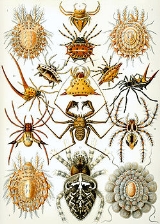
Arachnid
Overview
Arachnids are a class (Arachnida) of joint-legged
invertebrate
animal
s in the subphylum Chelicerata
. All arachnids have eight legs, although in some species the front pair may convert to a sensory function. The term is derived from the Greek
words (aráchnē), meaning "spider".
Almost all extant arachnids are terrestrial. However, some inhabit freshwater environments and, with the exception of the pelagic zone
, marine environments as well.
Arthropod
An arthropod is an invertebrate animal having an exoskeleton , a segmented body, and jointed appendages. Arthropods are members of the phylum Arthropoda , and include the insects, arachnids, crustaceans, and others...
invertebrate
Invertebrate
An invertebrate is an animal without a backbone. The group includes 97% of all animal species – all animals except those in the chordate subphylum Vertebrata .Invertebrates form a paraphyletic group...
animal
Animal
Animals are a major group of multicellular, eukaryotic organisms of the kingdom Animalia or Metazoa. Their body plan eventually becomes fixed as they develop, although some undergo a process of metamorphosis later on in their life. Most animals are motile, meaning they can move spontaneously and...
s in the subphylum Chelicerata
Chelicerata
The subphylum Chelicerata constitutes one of the major subdivisions of the phylum Arthropoda, and includes horseshoe crabs, scorpions, spiders and mites...
. All arachnids have eight legs, although in some species the front pair may convert to a sensory function. The term is derived from the Greek
Greek language
Greek is an independent branch of the Indo-European family of languages. Native to the southern Balkans, it has the longest documented history of any Indo-European language, spanning 34 centuries of written records. Its writing system has been the Greek alphabet for the majority of its history;...
words (aráchnē), meaning "spider".
Almost all extant arachnids are terrestrial. However, some inhabit freshwater environments and, with the exception of the pelagic zone
Pelagic zone
Any water in a sea or lake that is not close to the bottom or near to the shore can be said to be in the pelagic zone. The word pelagic comes from the Greek πέλαγος or pélagos, which means "open sea". The pelagic zone can be thought of in terms of an imaginary cylinder or water column that goes...
, marine environments as well.
Unanswered Questions

